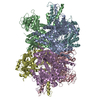+ Open data
Open data
- Basic information
Basic information
| Entry | Database: PDB / ID: 5k12 | ||||||
|---|---|---|---|---|---|---|---|
| Title | Cryo-EM structure of glutamate dehydrogenase at 1.8 A resolution | ||||||
 Components Components | Glutamate dehydrogenase 1, mitochondrial | ||||||
 Keywords Keywords | OXIDOREDUCTASE / glutamate dehydrogenase / small metabolic complex | ||||||
| Function / homology |  Function and homology information Function and homology informationglutamate dehydrogenase [NAD(P)+] activity / glutamate catabolic process / tricarboxylic acid metabolic process / glutamate dehydrogenase [NAD(P)+] / glutamate dehydrogenase (NADP+) activity / glutamate dehydrogenase (NAD+) activity / glutamine metabolic process / mitochondrial inner membrane / GTP binding / endoplasmic reticulum ...glutamate dehydrogenase [NAD(P)+] activity / glutamate catabolic process / tricarboxylic acid metabolic process / glutamate dehydrogenase [NAD(P)+] / glutamate dehydrogenase (NADP+) activity / glutamate dehydrogenase (NAD+) activity / glutamine metabolic process / mitochondrial inner membrane / GTP binding / endoplasmic reticulum / mitochondrion / ATP binding / identical protein binding Similarity search - Function | ||||||
| Biological species |  | ||||||
| Method | ELECTRON MICROSCOPY / single particle reconstruction / cryo EM / Resolution: 1.8 Å | ||||||
 Authors Authors | Merk, A. / Bartesaghi, A. / Banerjee, S. / Falconieri, V. / Rao, P. / Earl, L. / Milne, J. / Subramaniam, S. | ||||||
 Citation Citation |  Journal: Cell / Year: 2016 Journal: Cell / Year: 2016Title: Breaking Cryo-EM Resolution Barriers to Facilitate Drug Discovery. Authors: Alan Merk / Alberto Bartesaghi / Soojay Banerjee / Veronica Falconieri / Prashant Rao / Mindy I Davis / Rajan Pragani / Matthew B Boxer / Lesley A Earl / Jacqueline L S Milne / Sriram Subramaniam /  Abstract: Recent advances in single-particle cryoelecton microscopy (cryo-EM) are enabling generation of numerous near-atomic resolution structures for well-ordered protein complexes with sizes ≥ ∼200 kDa. ...Recent advances in single-particle cryoelecton microscopy (cryo-EM) are enabling generation of numerous near-atomic resolution structures for well-ordered protein complexes with sizes ≥ ∼200 kDa. Whether cryo-EM methods are equally useful for high-resolution structural analysis of smaller, dynamic protein complexes such as those involved in cellular metabolism remains an important question. Here, we present 3.8 Å resolution cryo-EM structures of the cancer target isocitrate dehydrogenase (93 kDa) and identify the nature of conformational changes induced by binding of the allosteric small-molecule inhibitor ML309. We also report 2.8-Å- and 1.8-Å-resolution structures of lactate dehydrogenase (145 kDa) and glutamate dehydrogenase (334 kDa), respectively. With these results, two perceived barriers in single-particle cryo-EM are overcome: (1) crossing 2 Å resolution and (2) obtaining structures of proteins with sizes < 100 kDa, demonstrating that cryo-EM can be used to investigate a broad spectrum of drug-target interactions and dynamic conformational states. | ||||||
| History |
|
- Structure visualization
Structure visualization
| Movie |
 Movie viewer Movie viewer |
|---|---|
| Structure viewer | Molecule:  Molmil Molmil Jmol/JSmol Jmol/JSmol |
- Downloads & links
Downloads & links
- Download
Download
| PDBx/mmCIF format |  5k12.cif.gz 5k12.cif.gz | 383.5 KB | Display |  PDBx/mmCIF format PDBx/mmCIF format |
|---|---|---|---|---|
| PDB format |  pdb5k12.ent.gz pdb5k12.ent.gz | 296.3 KB | Display |  PDB format PDB format |
| PDBx/mmJSON format |  5k12.json.gz 5k12.json.gz | Tree view |  PDBx/mmJSON format PDBx/mmJSON format | |
| Others |  Other downloads Other downloads |
-Validation report
| Summary document |  5k12_validation.pdf.gz 5k12_validation.pdf.gz | 1019.1 KB | Display |  wwPDB validaton report wwPDB validaton report |
|---|---|---|---|---|
| Full document |  5k12_full_validation.pdf.gz 5k12_full_validation.pdf.gz | 1 MB | Display | |
| Data in XML |  5k12_validation.xml.gz 5k12_validation.xml.gz | 55.2 KB | Display | |
| Data in CIF |  5k12_validation.cif.gz 5k12_validation.cif.gz | 79 KB | Display | |
| Arichive directory |  https://data.pdbj.org/pub/pdb/validation_reports/k1/5k12 https://data.pdbj.org/pub/pdb/validation_reports/k1/5k12 ftp://data.pdbj.org/pub/pdb/validation_reports/k1/5k12 ftp://data.pdbj.org/pub/pdb/validation_reports/k1/5k12 | HTTPS FTP |
-Related structure data
| Related structure data |  8194MC  8191C  8192C  8193C  5k0zC  5k10C  5k11C M: map data used to model this data C: citing same article ( |
|---|---|
| Similar structure data |
- Links
Links
- Assembly
Assembly
| Deposited unit | 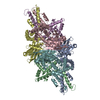
|
|---|---|
| 1 |
|
- Components
Components
| #1: Protein | Mass: 61608.910 Da / Num. of mol.: 6 / Source method: isolated from a natural source / Source: (natural)  References: UniProt: P00366, glutamate dehydrogenase [NAD(P)+] #2: Water | ChemComp-HOH / | |
|---|
-Experimental details
-Experiment
| Experiment | Method: ELECTRON MICROSCOPY |
|---|---|
| EM experiment | Aggregation state: PARTICLE / 3D reconstruction method: single particle reconstruction |
- Sample preparation
Sample preparation
| Component | Name: Glutamate dehydrogenase / Type: COMPLEX / Entity ID: #1 / Source: NATURAL |
|---|---|
| Molecular weight | Value: 0.334 MDa / Experimental value: NO |
| Source (natural) | Organism:  |
| Buffer solution | pH: 6.8 |
| Buffer component | Conc.: 100 nM / Name: Potassium phosphate |
| Specimen | Conc.: 3 mg/ml / Embedding applied: NO / Shadowing applied: NO / Staining applied: NO / Vitrification applied: YES |
| Specimen support | Grid material: COPPER / Grid mesh size: 200 divisions/in. / Grid type: Quantifoil R1.2/1.3 |
| Vitrification | Instrument: FEI VITROBOT MARK IV / Cryogen name: ETHANE / Details: Plunged into liquiq ethane (FEI VITROBOT MARK IV) |
- Electron microscopy imaging
Electron microscopy imaging
| Experimental equipment |  Model: Titan Krios / Image courtesy: FEI Company |
|---|---|
| Microscopy | Model: FEI TITAN KRIOS |
| Electron gun | Electron source:  FIELD EMISSION GUN / Accelerating voltage: 300 kV / Illumination mode: FLOOD BEAM FIELD EMISSION GUN / Accelerating voltage: 300 kV / Illumination mode: FLOOD BEAM |
| Electron lens | Mode: BRIGHT FIELD / Nominal magnification: 215000 X / Calibrated magnification: 78000 X / Nominal defocus max: 2100 nm / Nominal defocus min: 800 nm / Cs: 2.7 mm |
| Specimen holder | Cryogen: NITROGEN / Specimen holder model: FEI TITAN KRIOS AUTOGRID HOLDER / Temperature (max): 79.8 K / Temperature (min): 79.6 K |
| Image recording | Average exposure time: 0.4 sec. / Electron dose: 40 e/Å2 / Detector mode: SUPER-RESOLUTION / Film or detector model: GATAN K2 QUANTUM (4k x 4k) / Num. of real images: 232 |
| EM imaging optics | Energyfilter name: GIF Quantum / Energyfilter upper: 20 eV / Energyfilter lower: 0 eV |
| Image scans | Movie frames/image: 38 / Used frames/image: 3-9 |
- Processing
Processing
| Software | Name: PHENIX / Version: 1.10_2155: / Classification: refinement | ||||||||||||||||||||||||||||||||
|---|---|---|---|---|---|---|---|---|---|---|---|---|---|---|---|---|---|---|---|---|---|---|---|---|---|---|---|---|---|---|---|---|---|
| EM software |
| ||||||||||||||||||||||||||||||||
| CTF correction | Type: PHASE FLIPPING AND AMPLITUDE CORRECTION | ||||||||||||||||||||||||||||||||
| Particle selection | Num. of particles selected: 45388 | ||||||||||||||||||||||||||||||||
| Symmetry | Point symmetry: D3 (2x3 fold dihedral) | ||||||||||||||||||||||||||||||||
| 3D reconstruction | Resolution: 1.8 Å / Resolution method: FSC 0.143 CUT-OFF / Num. of particles: 21818 Details: The primary map in this entry corresponds to theuncorrected reconstruction. A version sharpened using a B-factor of -90 is provided as additional volume data. Symmetry type: POINT | ||||||||||||||||||||||||||||||||
| Atomic model building | Protocol: FLEXIBLE FIT / Space: REAL | ||||||||||||||||||||||||||||||||
| Atomic model building | PDB-ID: 1NR7 Accession code: 1NR7 / Source name: PDB / Type: experimental model | ||||||||||||||||||||||||||||||||
| Refinement | Highest resolution: 1.8 Å | ||||||||||||||||||||||||||||||||
| Refine LS restraints |
|
 Movie
Movie Controller
Controller




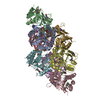
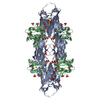
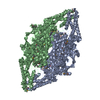
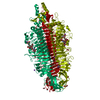
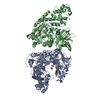
 PDBj
PDBj
